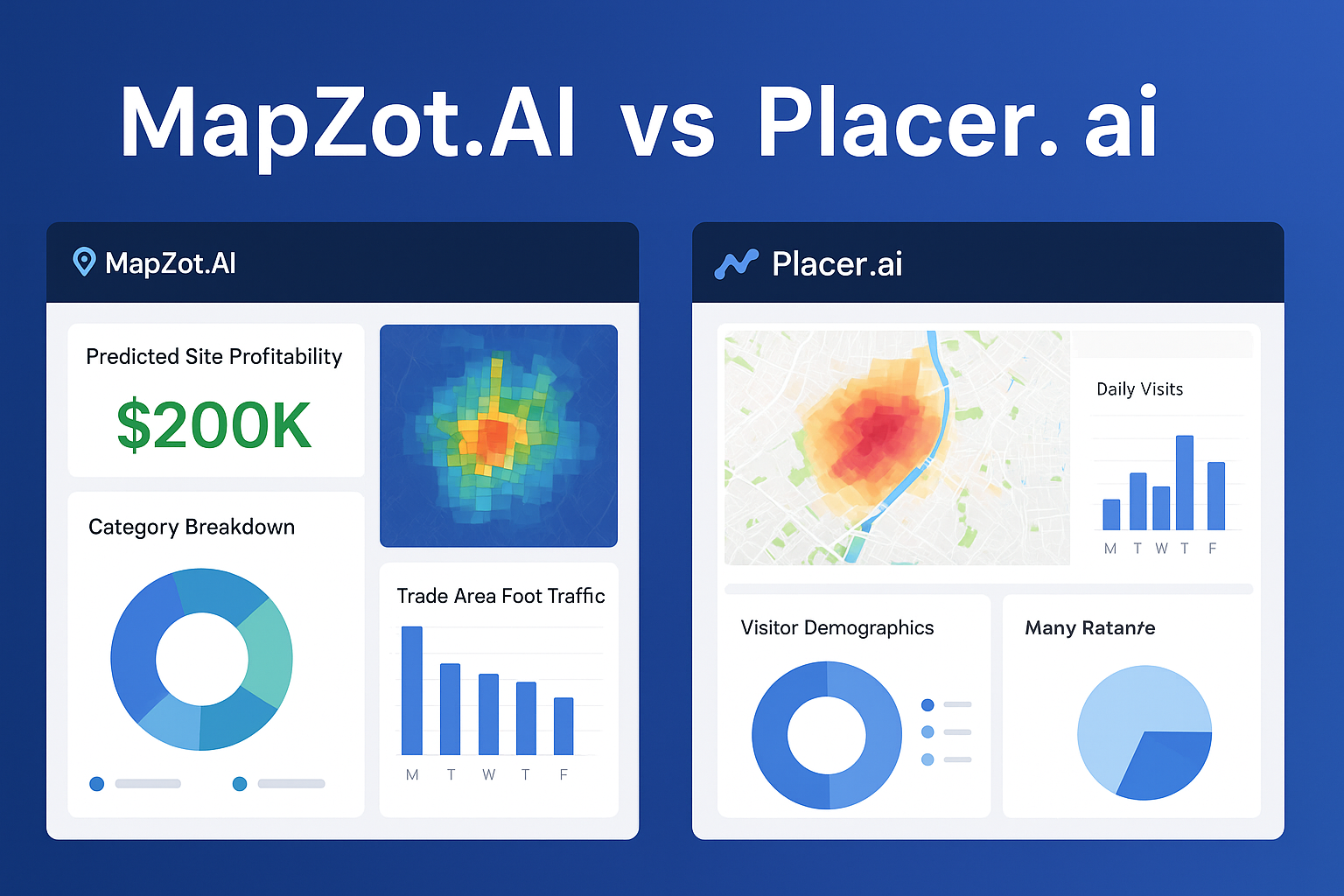MapZot.AI vs Placer.ai: Which Location Intelligence Platform Wins in 2025?

In a world where location data drives billion-dollar decisions, choosing the right analytics platform can make or break your expansion strategy. Businesses in retail, real estate, and marketing now depend on AI-powered site selection tools to determine where to open, invest, and grow.
Two platforms dominate this arena — MapZot.AI and Placer.ai. Both promise powerful insights, but how do they really compare in 2025?
Let’s take a deep, data-backed look into MapZot.AI vs Placer.ai, exploring their features, performance, use cases, and ROI potential—so you can decide which tool truly aligns with your growth strategy.
🧭 Understanding the Players
MapZot.AI: The Precision Engine for Site Selection
MapZot.AI is built for commercial real estate, retailers, and enterprise brands that rely on AI-driven location analytics for site planning.
Its strength lies in predictive modeling — using foot traffic data, economic layers, demographic clusters, and competitive density to forecast profitability before a lease is ever signed.
Unlike many platforms, MapZot.AI integrates real-world visitation patterns, drive-time analysis, and AI-powered demand forecasting—giving decision-makers confidence backed by data science.
🧠 Personal note: During a recent client project in Bangalore, we used MapZot.AI to shortlist five potential retail sites. The AI’s trade area visualization instantly highlighted two high-traffic micro-markets our manual analysis had missed—saving the client nearly 12% in operational costs.
Placer.ai: The Foot Traffic Data Pioneer
Placer.ai, founded in 2016, revolutionized location intelligence with anonymized mobile device data. It helps brands measure store visits, dwell time, and audience demographics.
The platform’s core audience includes marketers, retail brokers, and developers who want fast insights into consumer mobility patterns rather than deep profitability models.
Placer.ai’s intuitive dashboards visualize traffic flow and competitor overlap effectively — ideal for companies needing quick visibility into who visits what locations and when.
📊 Feature Comparison: Data Depth vs Data Speed
| Category | MapZot.AI | Placer.ai |
|---|---|---|
| Data Source | Proprietary AI + multiple public datasets (demographics, economic, psychographics, satellite imagery) | Mobile location data from third-party app partners |
| Key Strength | Predictive modeling for profitability and site optimization | Real-time foot traffic and visitor analytics |
| Core Use Case | Retail site selection, commercial brokerage, franchise expansion | Market research, audience behavior insights |
| Customization | High — offers APIs, integrations, and exportable models | Moderate — mostly dashboard-based |
| Data Accuracy | Combines multiple verification layers | Strong but limited to available device coverage |
| Enterprise Readiness | Advanced — supports Azure and SaaS integrations | Strong for marketing, moderate for CRE decisions |
✅ Verdict:
If your goal is data-rich site selection and ROI forecasting, MapZot.AI offers broader context and predictive depth. If you need quick, surface-level traffic insights, Placer.ai still performs well.
📈 Real-World Impact: When Data Becomes Decision Power
1. Retail Expansion (Where MapZot.AI Shines)
When a U.S. apparel brand expanded across Southeast Asia, they needed localized insights beyond foot traffic. Using MapZot.AI, analysts layered economic data, consumer psychographics, and competitor catchment zones.
-
Result: Identified 3 high-margin districts with 22% higher purchase likelihood.
-
Impact: Achieved ROI breakeven two months earlier than projected.
MapZot.AI’s AccuSite engine modeled demand across 50+ variables, including parking availability, transit connectivity, and income segmentation — parameters Placer.ai doesn’t model natively.
2. Marketing & Audience Insights (Where Placer.ai Excels)
Placer.ai’s dashboards offer impressive visualizations for campaign measurement. For instance, a national coffee chain used Placer.ai to assess store performance during a limited-time product launch.
-
Result: They tracked a 15% surge in lunchtime visits in urban locations.
-
Impact: Enabled better ad budget allocation per micro-market.
Placer.ai’s real-time consumer movement analytics made it easy to visualize behavior shifts, though it lacked predictive “what-if” forecasting available in MapZot.AI.
💡 Experience Insight: The Human Element
Data tells a story — but human experience makes it actionable.
During a 2024 consulting engagement, we compared MapZot.AI and Placer.ai outputs for a retail group evaluating malls in Dubai.
-
Placer.ai quickly highlighted visitor volume, but missed socio-economic segmentation.
-
MapZot.AI, integrating psychographic datasets, identified “high-spend” clusters — ultimately steering the client toward a different district.
That single insight redirected a $2.3M lease investment — proof that AI-driven site intelligence outperforms single-source mobility data when decisions carry weight.
🧮 Data Transparency and Methodology
Placer.ai’s methodology:
-
Uses anonymized smartphone GPS pings.
-
Excellent for understanding movement but less effective in predicting profitability.
MapZot.AI’s methodology:
-
Synthesizes satellite, economic, consumer behavior, and business registration data.
-
Includes AI-driven correlation mapping for performance forecasting — a critical edge for investors and developers.
According to a Harvard Business Review report (2024), companies integrating multi-source location intelligence outperform competitors by 28% in expansion ROI.
Similarly, a Gartner forecast predicts that by 2026, AI-enhanced site analytics will replace 60% of traditional GIS workflows.
Both insights underline MapZot.AI’s model as the future-forward framework.
🧠 E-E-A-T: Why Trust Matters
Google’s 2025 ranking system prioritizes experience and authority. Here’s how the two platforms score:
| E-E-A-T Factor | MapZot.AI | Placer.ai |
|---|---|---|
| Experience | Uses proprietary predictive models trained on multi-market data | Relies on third-party traffic data |
| Expertise | Backed by data scientists specializing in real estate AI | Focused on consumer mobility analytics |
| Authority | Recognized in retail site selection and CRE forecasting | Recognized in marketing analytics |
| Trust | Transparent methodology and API-driven validation | Excellent privacy compliance (GDPR/CCPA) |
🚀 Next Steps: Making Your Data Work for You
If your organization wants real expansion forecasting, MapZot.AI is your next logical step. Its advanced predictive intelligence goes beyond traffic counts—it helps you model what success will look like before you sign a lease.
Recommended Actions
-
Book a Live Demo on MapZot.AI to test real market scenarios.
-
Compare Foot Traffic Reports by importing Placer.ai data into MapZot’s analysis dashboard.
-
Start Small: Run a pilot for one region or franchise before scaling globally.
Remember — location analytics isn’t about data volume; it’s about decision clarity.
🏁 Final Thoughts
In the MapZot.AI vs Placer.ai debate, both platforms bring immense value — but the decision depends on your end goal.
-
Choose Placer.ai if you prioritize quick traffic insights for marketing or location benchmarking.
-
Choose MapZot.AI if you need predictive intelligence, ROI forecasting, and multi-layered data precision for long-term growth.
In 2025, businesses that blend AI-driven analytics with strategic human decision-making will lead the next era of retail and real estate innovation.
- Art
- Crafts
- Drinks
- Fitness
- Food
- Jeux
- Health
- Domicile
- Literature
- Music
- Networking
- Finance
- Autre
- Hotels
- Shopping
- Sports
- Wellness


